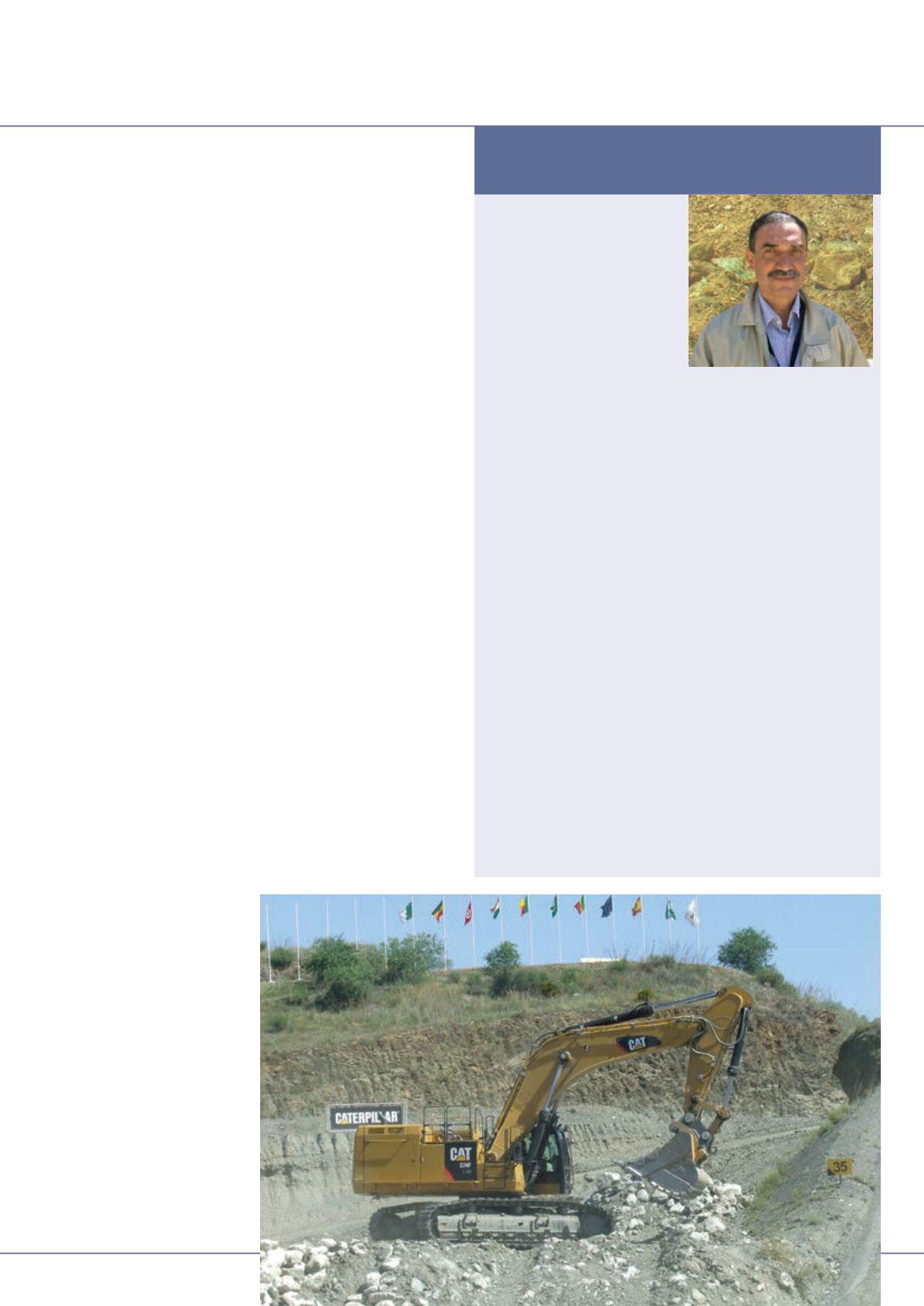
EQUIPMENT
58
international
construction
june 2014
Caterpillar
As a productionmachine, the 950
H canbe fittedwith a slightly larger
maximumbucket size than the 950
GC, and some of its rear structures
aremore robust.However, the 950
GChas a bitmore dump clearance
tohelpwith truck loading.The
front end is a traditional Z-bar
linkage, andwhileCaterpillar
says themachine canbe used for
productionwork, it is intended
more for lighter applications.
Power comes from a 168kW
CatC7.1 engine, whichmeets
Stage IIIA/Tier 3 emission laws
and the company says this has a
fuel injection systemdesigned to
copewith the poorer quality fuels
that are often found in emerging
countries.There is anon-demand
fan and the robust cooling system
means the loader canbe used in
temperatures up to50°C.
The simple technology theme is
apparent in the powertrain, which
provides four forward and three
reverse speeds via aCaterpillar-built
powershift transmission.The axles
feature in-boardplanetary drives
andwet disc brakes, and limited-
slipdifferentials are available as an
option.
Workhorse excavator
Anothermachine thatCaterpillar
has rethought is the 20 tonne class
320D2 tracked excavator.This is
by far themost popular excavator
sizeworldwide, particularly in
emergingmarkets, andCaterpillar’s
discussionswith customers led
it to the conclusion that greater
simplicitywouldbe theway to
improve it.
One of the key aspects of this
was to go from an electronic to
mechanical engine tohelpwith
fuel quality issues. AlexFavero,
Caterpillar’s hydraulic excavator
product application specialist for
EAME said, “For theMiddleEast
andAfrica, the quality of fuel is
very low. In electronic engines,
the pressures is huge, 2,000bar or
so in the injectors, so if you get a
blockage youhave a huge problem.
In amechanical system, the pressure
is only around200bar.”
This greater tolerance topoor
fuel shouldnot onlymean greater
reliability, but it has also allowed
Caterpillar to generate potential
savings in consumables.The
previous 320Dhad four fuel filters,
with a recommended replacement
interval of 250hours.Now there
are just two, and the interval has
been stretchedout to500hours, so
this aspect of themachine’s running
cost is a quarter of what itwas.
Despite the change to a less
sophisticated engine, Caterpillar
says there is about a 3% fuel
efficiency improvement on this
machine over the previousmodel,
compared to the last. Another
change is the in-cabmonitor and
newEcomode.Themachine always
starts up inEcomode as a default
(althoughowners can change this
setting).The operator can switch
toPowermode if required, but
Caterpillar says running inEcowill
save 10% to15% in fuel costs.
More to come
These twomachines are just part
of a newportfolioof equipment
Caterpillar is launching in the
MiddleEast andAfrica this year.
The 320D2 is just one of nine
tracked excavators thatwill be
released to cover the 20 to90 tonne
operatingweight classes. It is a
wide spreadofmachines, but asMr
Lavassani said, “Excavators are 70%
of themarket in the region.”
In addition, there are twowheeled
excavators to come alongwith a
grader and scraper.
iC
The 75 tonne class 374F is one
of nine tracked excavators
Caterpillar will launch in Africa
and theMiddle East this year.
Rental expansions
Pioneering Tunisian dealer plans for growth
P
arenin, Caterpillar’sdealer
inTunisia, hasbeen
formally rentingmachines
for 15 years, andexpects its
fleet tobreak the100machine-
markwithin thenext two years.
Thismaynot sound likemany
byEuropean, Japaneseor US
standards, but it isbelieved tobe
Tunisia’sbiggest rental fleet.
Andkeydifference in theway
thecompanyoperates itsCat Rental Store franchisecompared toother
partsof theworld is that all themachines it rentsgooutwithanoperator
trainedunder aCat-certifiedprogramme. According toMustapha
Farjallah (pcitured), Parenin’smanager for rental andusedequipment,
thishelps ensuremachinesareused safely,maintainedandnot abused.
It alsohelps toensurepayment andprevent theft.
“Wewill continuewithoperators for a few yearsat least. Nowwehave
VisionLink (Cat’s telematics system),wemight beable tochange things
anduse that to follow themachineand trackmaintenance. But for now
wehave70machinesand70operators,” saidMr Farjallah.
Andhe said thefleet is set togrow. “Wehave lotsof newbusiness
opportunities. Therearehighwaysbeingbuilt aswell asagaspipeline
andweneed tobe ready for that. Iwill reach100machineswithin two
years.Wehavea lot of businessbecauseTunisia isapermanent job site
thesedays,” saidMr Farjallah.
But as inany embryonic rentalmarket, oneof thebigchallenges is to
overcome theownershipmentalityamongcontractors. “Theculture in
Tunisia is toownmachines, so it hasbeenhardwork tochange that.We
have focussedon foreigncompaniesbecause theyprefer to rent,”he
added
AndMr Farjallah saidall thecompletionParenin faced in the rental
sectorwasof amore ‘informal’ kind. “Weare theonly structured rental
company (inTunisia). Thecompetitionwehaveare ‘taxi stand’ people,
whobuyamachine likeabackhoe loader and rent their services.”
However, he said thatmore serious competitionwason thehorizon.
“Weareapioneer for rental inTunisia. I think therewill beamore
structuredcompetition in the future. I believeVolvo is lookingandLoxam
hasmadea studyof themarket,”heconcluded.


